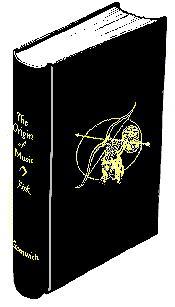Buy this book

Among the first reviews of the "Origin of Music" (under its original title: "The Universality of Music") was published by the "Journal of Research in Music Education," Vol. 20, No. 3, (Autumn, 1972 p. 412), by Vada E. Butcher, professor of music at Howard University, Washington, D.C.
Butcher wrote: "According to the author, this book proposes 'a complete theory of the laws and forces governing the
origin and development of music.' Fink considers his theory unique in that he assigns equal weight to natural
laws and cultural forces in explaining the phenomenon of music. He maintains that those elements common to
the music of most societies of the world -- preference for the octave, fifth, and fourth; predominance of
pentatonic and diatonic scales; and the distinction between noise and music -- all can be explained by
acoustical principles."
Butcher goes on to explain the core theory in Fink's book, which is that the pentatonic scale, the diatonic scale, major and minor, and the concept of tonality itself (or a sense of key and keynote), are created from the overtones of the tonic, fifth, and fourth intervals, which Fink points out are are found in nature, (ram's horns, echos and voices, for examples), and which therefore are most used and familiar to the music makers in almost all cultures.
The originality Fink claims for his view is that other writers, even Helmholtz, looked into the cycle of 5th as influences in the forming of scales, and looked at the overtones of only a single note, which may have hinted at an explanation of some things. Fink appears to be the first to use the combined overtones of the three most used intervals.
When considered as a "trio," Fink, as Butcher notes, created a chart:
The most audible overtones produced by the trio of tonic, fifth and fourth can be listed just so (in the key of C, but
true in any key, and listed in the order of the loudest to the less audible overtones):
Tonic: C --Overtones C, G, E, Bb (or B-flat)
Fifth: G --Overtones G, D, B, F
Fourth: F--Overtones: F, C, A, Eb (or E-flat)
This chart represents the loud and soft of only those notes that were heard most often by prehistoric peoples.
Wrote Butcher: "The tones E, B, and A are "weak" tones, inviting alterations that result in the minor scale...and
the "blues" scale...."
From the chart, it can be seen that leaving out the weak tones altogther (except the A because it forms no
half-tones with the other notes) you get the pentatonic scale.
Finally, the weakest tones, Eb and Bb in particular, were often chosen to replace the E and B, thus
producing a minor scale. Or creating the blues scale, if those gaps are filled with a note tuned between the E and Eb and
likewise, between the B and Bb.
The weak and strong notes gave rise to a sense of tonality and key, such as reflected in the terms tonic (C,
loudest), dominant (G, next loudest) and subdominant (F, next loudest).
The half tones in the diatonic were tolerated because they played a role in melody as "passing" notes to
the more dominant notes, eventually getting added to the pentatonic as full members of the scale, creating the diatonic
scale. As these tones crept into the scale, the chinese called them "pien" tones, meaning "on the way to."
The rest of the book elaborates on the historic unfolding of these acoustic influences in detail, the role of
non-acoustic influences, and deals with the debates and criticism of those who resist all theories which imply any
natural foundation to musical sound.
Another review in Jazz Journal in March 1971 (Vol. 24 No. 3) notes that Fink's "remarkable book could
become a classic if given the expopsure it deserves."
Fink has since authored numerous other works on music's origins, including analysis of the famed 45,000
year-old earliest known instrument, the "Neanderthal Flute."
More information can be found at: http://www.greenwych.ca/og-ez.htm .
Buy this book

Previews available in: English
Subjects
Music, music theory, history of music, Origin, Musique, OriginesShowing 3 featured editions. View all 3 editions?
| Edition | Availability |
|---|---|
| 1 |
zzzz
Libraries near you:
WorldCat
|
|
2
The origin of music: a theory of the universal development of music
1981, Greenwich Publishers
Hardcover
in English
|
aaaa
|
|
3
The origin of music: a theory of the universal development of music
1981-01-01, Greenwich-Meridian
0912424060 9780912424064
|
zzzz
Libraries near you:
WorldCat
|
Book Details
Edition Notes
Includes bibliographical references and index.
Previously published as: The universality of music.
"Ltd. edition of 100 copies"--Label on p. 279.
LC has no. 17.
Classifications
The Physical Object
ID Numbers
Community Reviews (0)
Feedback?| January 24, 2021 | Edited by ImportBot | import existing book |
| September 19, 2012 | Edited by 130.25.57.6 | Added new cover |
| December 27, 2011 | Edited by LC Bot | import new book |
| March 16, 2011 | Edited by girl2k | Edited without comment. |
| December 9, 2009 | Created by WorkBot | add works page |










